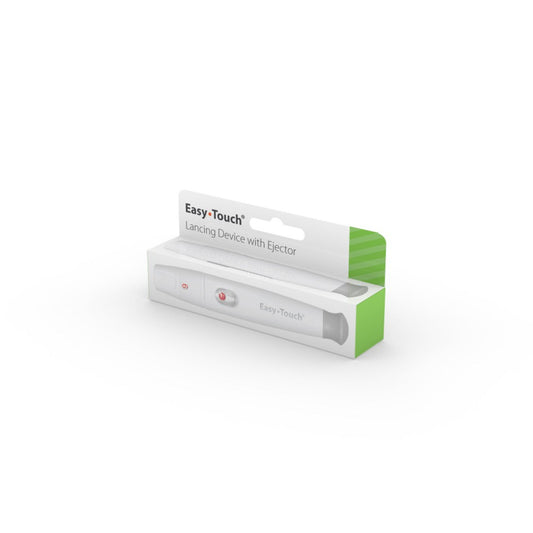-
Easy Touch Lancing Device w/ Ejector, 808002
Regular price $6.45 USDRegular priceUnit price / per$7.99 USDSale price $6.45 USDSale
Collection: Lancing Device
Lancet Device: A Comprehensive Guide to Safe Blood Sampling
Introduction
A lancet device is a crucial tool used for safe and efficient blood sampling in various medical procedures. It is commonly used for glucose monitoring in individuals with diabetes, as well as for other diagnostic tests that require a small blood sample. Understanding how to use a lancet device properly ensures accurate results and minimizes discomfort during blood sampling.
Understanding Lancet Devices
A lancet device is a handheld instrument designed to safely and precisely puncture the skin and create a small incision for blood sampling. It typically consists of a spring-loaded mechanism that releases a lancet needle when triggered. The depth of needle penetration can often be adjusted to accommodate different skin types and sampling needs.
1. Benefits of Using a Lancet Device
Lancet devices offer several advantages over traditional methods of blood sampling:
- Safety: The controlled release of the lancet needle minimizes the risk of accidental injury or needlestick.
- Precision: Lancet devices allow for consistent and accurate sampling depths, ensuring reliable blood samples for testing.
- Comfort: The adjustable depth settings and fine gauge needles of lancet devices help reduce pain and discomfort during blood sampling.
- Convenience: The portable and easy-to-use nature of lancet devices makes them suitable for at-home use and on-the-go blood sampling.
2. Choosing the Right Lancet Device
When selecting a lancet device, consider the following factors:
- Depth Settings: Look for a device with adjustable depth settings to accommodate individual preferences and skin types.
- Needle Gauge: The gauge of the lancet needle determines its thickness. Thinner needles, such as 30 or 33 gauge, often cause less discomfort during sampling.
- Trigger Mechanism: Consider the ease of use and reliability of the trigger mechanism, ensuring a smooth and controlled release of the lancet needle.
Tips for Using a Lancet Device
Proper technique is crucial for safe and effective blood sampling using a lancet device. Consider the following tips:
1. Preparing for Blood Sampling
- Ensure that the lancet device is clean and in good working condition.
- Wash hands with warm water to improve blood circulation and cleanliness.
- Prepare the testing site by cleaning it with an alcohol swab and allowing it to dry completely.
2. Using the Lancet Device
- Set the desired depth of penetration on the lancet device according to the manufacturer's instructions and individual preference.
- Hold the lancet device firmly against the chosen site and press the trigger or button to activate the lancet needle.
- Quickly release the trigger to ensure a controlled and precise puncture.
- Gently massage the area to encourage blood flow and facilitate the collection of an adequate blood sample.
3. Safe Disposal
- After use, immediately dispose of the used lancet and lancet device in a puncture-resistant sharps container.
- Follow local regulations and guidelines for the proper disposal of sharps containers.
Conclusion
A lancet device is a valuable tool for safe and efficient blood sampling in various medical procedures, particularly in glucose monitoring for individuals with diabetes. By understanding how to properly use a lancet device and following best practices, individuals can ensure accurate results and minimize discomfort during blood sampling.
When choosing a lancet device, consider factors such as adjustable depth settings, needle gauge, and the reliability of the trigger mechanism. Proper preparation, technique, and safe disposal practices are essential for optimal blood sampling and maintaining a safe environment.
Using a lancet device correctly enables individuals to obtain reliable blood samples for diagnostic testing, monitor their health conditions, and make informed decisions about their well-being. By following guidelines, individuals can confidently and safely perform blood sampling procedures, contributing to their overall healthcare management.

